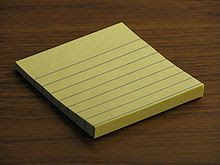A Post-it note is a piece of stationery with a re-adherable strip of adhesive on the back, designed for temporarily attaching notes to documents and other surfaces. Although now available in a wide range of colors, shapes, and sizes, Post-it notes are most commonly a 3-inch (76 mm) square, canary yellow in color. A unique low-tack adhesive allows the notes to be easily attached and removed without leaving marks or residue, unless used on white boards.
Post-it notes were invented by 3M's Art Fry, using an adhesive developed by a colleague, Spencer Silver. Until the 1990s, when the patent expired, they were produced only in the 3M plant in Cynthiana, Kentucky. Although other companies now produce sticky or repositionable notes, most of the world's Post-it Brand notes are still made in Cynthiana.
The term "Post-it" and the canary yellow color are trademarks of 3M. Accepted generic terms for competitors include "sticky notes", "repositionable notes", and "repositional notes". To take advantage of the success of the brand, 3M manufactures other products related to the Post-it concept.
History
 |
| A pad of fan-folded Post-it pop-up notes, shown still glued together, |
In 1968, Dr. Spencer Silver, a chemist at 3M in the United States, accidentally developed a "low-tack", reusable, pressure sensitive adhesive. For five years, Silver promoted his invention within 3M, both informally and through seminars, but without much success. In 1974, a colleague of his, Art Fry, who had attended one of Silver's seminars, came up with the idea of using the adhesive to anchor his bookmark in his hymnbook. Fry then developed the idea by taking advantage of 3M's officially sanctioned "permitted bootlegging" policy.3M launched the product in 1977, but it failed, as consumers had not tried it. A year later, 3M issued free samples to residents of Boise, Idaho, and 90 percent of the people who tried them said that they would buy the product. By 1980, the product was being sold nationwide in the US; in 1981 Post-its were launched in Canada and Europe.
In 2003, the company came out with Post-it Brand Super Sticky notes, with a stronger glue that adheres better to vertical and non-smooth surfaces.
Standard Post-it Brand notes have only partial adhesive coating on the back, along one edge. Similar products are used for specialized purposes with full adhesive coating; the US Post Office uses such yellow address labels to forward mail.
The yellow color was chosen by accident; a lab next-door to the Post-it team had scrap yellow paper, which the team initially used.
Use in art
Post-it notes used to make a mosaic
In 2004, Paola Antonelli, a curator of architecture and design, included Post-it notes in a show entitled "Humble Masterpieces". Rebecca Murtaugh is a California artist who uses Post-it notes in her artwork; in 2001, she created an installation by covering her whole bedroom with $1000 worth of the notes, using the ordinary yellow for objects she saw as having less value and neon colors for more important objects, such as the bed. Since 2002, Jésica López of Monterrey, Mexico, has been painting series of figures and portraits with acrylic on Post-it notes to depict, for instance, the faces of the "101 most powerful women" identified in the Forbes list of 2006. Some artists create entire murals of colored Post-it notes.
In 2000 the 20th anniversary of Post-it notes was celebrated by having artists create artworks on the notes. One such work, by the artist R. B. Kitaj, sold for £640 in an auction, making it the most valuable Post-it note on record.
In 2003, the Post-it note had a central role in a new play, Inside a Bigger Box (written by Trish Harnetiaux and directed by Jude Domsky), that premiered in New York City at the 78th Street Theatre. In conjunction with the show, Harnetiaux, Domski and the artists' non-profit organization NurtureART curated an International Post-it Brand Note Art exhibit and a panel discussion with various artists. Post-it inventor Art Fry participated in the panel, which was curated by the current MOMA head of design Paola Antonelli.
Post-it notes are also used by film producers to lay out scenes. They provide a simple means of storyboarding a project on the go, allowing easy removal or rearrangement of "shots" in the storyboard.
Use in technology
Analogues of Post-it notes have also been used in technology in the form of desktop notes—computer applications developed to allow users to put virtual notes on their computer desktop. These computerized versions of Post-it notes include 3M's own "Post-it Brand Software Notes", Apple's "Stickies" and Windows 7's "Sticky Notes". Microsoft is working on a "Super Sticky Notes" application for a future Windows 7 service pack which allows for prioritization of items typed into the virtual Post-it.
(source:wikipedia)



No comments:
Post a Comment